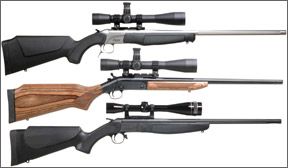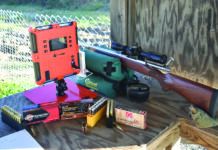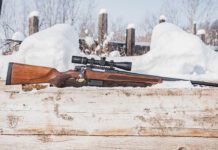The concept of a single-shot rifle for modern usage goes back quite a few years. Despite the advent of repeating firearms, the single-shot rifle has always held its own, from the Sharps down to the H&R Ultra rifle tested here. Many makers have put together some very fine and also some not-so-fine single shots on a great variety of actions. This test looks at three relatively simple rifles. Two of them are from CVA in the form of the 308-caliber Apex CR4502S and the less-expensive Scout in 30-06. We also acquired one of the U.S.-made H&R 1871 Ultra Hunters in 308. We tested the 308s with three types of ammunition, Remington 180-grain Core-Lokt, Winchester 150-grain Power Point, and Winchester Supreme 168-grain HPBT match. In the 30-06 CVA Scout we used Winchester 180-grain Power-Point Plus, some M2 ball from Lake City Arsenal, and Speer Nitrex 165-grain JSP. Could the H&R compete against the Spanish-made CVAs? Here’s what we found.

CVA Scout No. CR4310 30-06 Spfld., $340
We began our testing with the Scout, and we liked it right from the start. It came to us with a 3-10X Konus Pro scope mounted. The rifle opened easily by pulling rearward on a button protruding in front of the trigger guard. It had a highly visible rebounding hammer, and above all, the rifle was light even with that big scope mounted. The balance was very good too.
The Scout could be cocked if it were open, but the action could not then be closed. If it were cocked, it could not be opened. We noted it was necessary to close the Scout briskly when there was a cartridge in the chamber or it might not lock fully, which prevented us from cocking the hammer.
The stock was matte black polymer with decent checkering, and like the Apex it was fully ambidextrous. There was a cheekpiece on each side of the stock, and the little hammer extension could be removed and put into the other side. The fluted barrel added a classy touch to this low-cost rifle. It came with a scope mount and rings as normal equipment. The scope was an extra-cost item. The metal finish was an excellent, smooth matte bluing. There were sling-swivel studs, and a soft, thick recoil pad that helped us avoid any pain during our test shooting.
There was none of the stiffness to the action that normal break-in removes. Will it work loose too quickly? We don’t know. The trigger pull was excellent, breaking at 3.9 pounds. Throughout our test session there were no problems with the rifle other than an occasional failure on our part to ensure the rifle was fully closed, but we did have a major complaint about getting the empties out. They dragged on the extractor, making it extremely annoying to get the spent case out. The extractor didn’t pull the case very far out, only 0.15 inch, so it was a pain to have to pick at it to get it out. If your fingers are cold, as they usually are on a hunt, good luck if you need a second shot. We eventually used a fired-case rim to pull out the empty. The extractor also was spring loaded upward against the fired case, making extraction more difficult. We would have liked the empties to at least fall free, or to have been kicked out by an ejector.
On the range we had one disaster after another. Our first group with the Winchester 180-grain was pushing 5 inches. Along the way we fired one group of 0.8 inch with that ammo, and that was the highlight of the Scout’s dubious accuracy. Next up, the mil-spec ball put them into 7 inches or so. The premium Speer Nitrex did not do much better, with groups about 5 inches. In desperation we changed the scope to our 12X Leupold, and were then able to shoot one group with the Winchester 180 of 1.7 inches, but the mil-spec ammo did only 7 inches, and the Nitrex 4.5 inches. We think this rifle provides a level of accuracy with our test ammo that’s borderline unacceptable. However, we persisted and shot some other types of ammo (unreported) and got slightly better results. The best average groups were around 3 inches, with commonly two of the shots much closer, as close as half an inch. We suspect careful selection of best load and perhaps more shooting will help the rifle achieve significantly better accuracy.
Our Team Said: CVA got a lot right with this handy single shot, from its light weight to its simple yet robust construction, including the shape and feel of the stock. Unfortunately, it wouldn’t shoot for us. We tightened the forend to no avail. We double-checked the scope base security. We tried other types of ammo. We got one three-shot group of 0.8 inch, and then fired one that was 4.6 inches. We varied the contact on the forend, and shot it with our hand under it. Nothing helped much. We suspect the problem is irregular support for the barrel. There’s nothing keeping it from going wherever it wants while the bullet travels down it, and that puts the impact just about anywhere it wants to be. There is no forend iron as such. The plastic forend just sits there and exerts very little corrective force on the barrel, it seems. We’re guessing, because we don’t know what to do here. Glass bedding the forend might help, but as of now we are not happy with the level of accuracy it provided.
Apex 4502 Stainless/Black 308 Win., $652
Like the Scout, the Apex is made in Spain and marketed by CVA. Our rifle came in the door as a 270, with black stock and stainless metalwork. For $80 more you can get a “Realtree” camo stock on your Apex rifle. The rifle came with a sling and QD scope rings, and a scope rail attached to the barrel. Embedded on each side of the matte-stainless action was the Apex name colored black. Beneath the action were two proof marks, the stamped-in serial number, and the CVA logo in laser etching. The action can be fitted with a baker’s dozen different calibers, including muzzleloader and rimfire. Each centerfire or rimfire barrel will cost you $352. A muzzleloader barrel will set you back $313. If you want more horsepower, the company offers the 45-70 or 35 Whelen in its biggest sizes. Any different calibers would require serious gunsmithing. We were told this has been done, so different calibers are not easy, but not entirely out of the question.
The Apex appealed to us right away because of its good looks, easy operation, and impeccable balance. Workmanship seemed to be very good everywhere we looked. With its trim stock and fluted barrel it felt just right in the hands. The CVA rifle people told us the Apex cannot be fitted with a wood stock, because the resultant wood would have some thin spots to fit around the innards, and this thin wood could easily break. So don’t consider spending lots of money on a fancy wood stock that ultimately you can’t use.
We also liked the feel of the stock. The gripping areas were covered in a rubbery checkered material that gave excellent traction. The action and fluted barrel were matte stainless steel. The flat-black polymer stock had a thick, soft recoil pad. Like that of the Scout, the stock was ambidextrous. It brought the eye up to just the right place for scope use. The web sling was attached via slim thumb screws. The sling was very easily adjustable for length with a keeper at the bottom. A rubber section bonded to the sling kept it from slipping off your shoulder, though it could not be repositioned. On the good side, it could not slide out of place.
The action opened by pulling upward on the rear extension of the trigger guard, and operation was smooth and easy, whether opening or closing the rifle. The hammer could not be cocked until the action was fully locked shut, and the action could not be closed if the hammer were in the cocked position. The hammer extension could be unscrewed (left-hand thread) and put in the other side for lefties. Thus the Apex was perfectly ambidextrous.
The Apex had no ejector, a lack we came desperately to wish for, just like with the Scout. We obtained a barrel in 308 and fitted it to the Apex for our testing. To change barrels you remove the forend, held by two slotted screws. These go directly into the bottom of the barrel. You then open the action and punch out the hefty hinge pin (10mm), lift out the old and drop in the new. There was no forend iron as such. Lockup seemed to be very secure. We noted the new barrel had a small screw in its bottom that bore against the bottom of the action when closed. The previous 270 barrel didn’t have that screw. This may have been the “new trick” that was supposed to improve accuracy. This may also be significant to the problems we encountered.
The trigger was easily adjustable from about 3 to 5 pounds pull. We left it alone at its 3.2-pound creep-free pull. The scope rail was secured by four Torx-head screws, and it accepted Weaver-type rings. Having lost time wondering about the low-cost scope on the Scout, we mounted our Leupold Mark 4 16X40 tactical scope ($1875) and took the Apex to the range.
The first shots with Remington 180-grain Core-Lokt continued to disappoint us in the accuracy department. Groups were 5-inchers. Changing ammo, we went to Winchester 150-grain loads and got 4-inch groups. The Winchester Supreme match ammunition finally got us groups around an inch, so there was some hope for this rifle. Yet why did it refuse to group well with some of the finest ammunition made today? The construction was similar to that of the CVA Scout, with a plastic forend lightly touching the action, so there was not much way for the forend to exert pressure onto the barrel. We tried holding the forend in our hand as well as resting it on the machine rest at different points. Nothing seemed to give us the respectable accuracy we had hoped for from this otherwise nice little rifle. At the time of our shooting we had not discovered the little screw under the barrel. Altering its pressure might help the accuracy situation. We ran out of time before we could try. One possibility might be to put a very firm but flexible pad under that screw to give consistent positioning pressure on the barrel. As it is, it relies on metal-to-metal contact, which at best is inconsistent between barrels and actions.
An online search indicates other shooters have not had accuracy problems with the Apex. We hope to try other tricks as time permits, but at deadline we have two very nice rifles that don’t satisfy in the accuracy department. Clearly, the problem is not with our shooters. On the same test day, one of our shooters fired a three-shot 1.2-inch group with iron sights at 100 yards from a 416 Taylor, full loads.
Our Team Said: We were initially quite fond of the rifle in all its little ways, but ultimately didn’t like it because of its questionable and inconsistent accuracy. Everything else about the rifle was just fine, from its finish and workmanship to its trigger pull, the stock, balance, recoil pad, etc. If the accuracy problem can be solved, this rifle would get our top marks. As of this writing we’re still searching for acceptable accuracy in the CVA products.
H&R 1871 Ultra Hunter No. SB2-808
308 Win., $374Harrington & Richardson, currently owned by Remington, still makes its guns in the U.S. Our 308 Ultra came with a sturdy laminated stock with a durable finish, thick but firm recoil pad, matte blued metal, and a 22-inch medium barrel. This was a no-frills package, though the stock was quite attractive with its non-glare finish and decent checkering. The gun opened by a press-down button to the right of the hammer. Opening and closing the action was a bit stiff, but it loosened somewhat during our test sessions. The barrel had a rail for Weaver-type bases, secured with three Torx screws. No scope rings were provided.
Not much came with the rifle but a padlock and a hammer extension for scope use. No sling, no scope rings. The instructions told us to be sure to mount the hammer extension before installing a scope. We tried, but failed. The 8-32 threaded hole in the extension was not tapped cleanly all the way through. We had to run a tap in there and only then could secure the extension to the hammer.
The hammer operated through a striker bar that was raised by pressing the trigger. The rifle could not be opened if the hammer were cocked, but it was possible to cock the hammer with the rifle open and then close the rifle on the cocked hammer. Because the rifle cannot fire unless the trigger is pressed, the latter situation is not as alarming as it might otherwise be.
We could not help but notice the stock felt clumsy in the controlling hand. The pistol grip was big and fat and not to our liking. By comparison, the CVA rifles were very good in this area. We’re sure the H&R is very strong, and if you don’t like the stock you can opt for a thumbhole stock, for slightly extra cost. The company website (www.hr1871.com) indicates you can get a thumbhole stock on the blued Ultra test rifle, but doesn’t give prices for anything.
The metal finish throughout had a brushed look, or the result of surface grinding. This was pleasant, and provided a matte surface for the excellent bluing. The forend iron and trigger guard were hard polymer. The forend wood was finished internally, and was fitted around a stout stud that was spot welded to the bottom of the barrel. This stud accepted the single large Phillips-head screw that secured the forend to the rifle. The trigger pull was clean but way too heavy at 6 pounds.
We mounted our Leupold 16x tactical scope and headed to the range. We began with the Remington ammunition, and made some three-shot groups of around 3 inches. The Winchester 150-grain did better, around 2 inches. Finally the match ammo gave us the smallest group of this test, 0.7 inches, with an average of 1.4 inches. This rifle shot all three types of ammunition respectably, if not majestically. The trigger was a terror, and it needed to be several pounds lighter. We wonder how much better we might have shot with a better trigger.
Our Team Said: We thought the rifle needed an ejector, though picking the empties out of the H&R was a bit easier than with the CVAs. Some might want a mushier recoil pad, but we liked what was on it, and particularly liked the excellent fitting of the pad to the stock. Although we liked the feel and looks of the Apex and even the Scout more than the look of the H&R, we would buy this rifle over them in light of its reasonable performance. We thought it was a solid, sound rifle that didn’t ask for much, and gave plenty of performance for its modest cost.































When someone writes an article he/she retains the plan of a user in his/her brain that how a user can understand it. So that’s why this paragraph is great. Thanks!